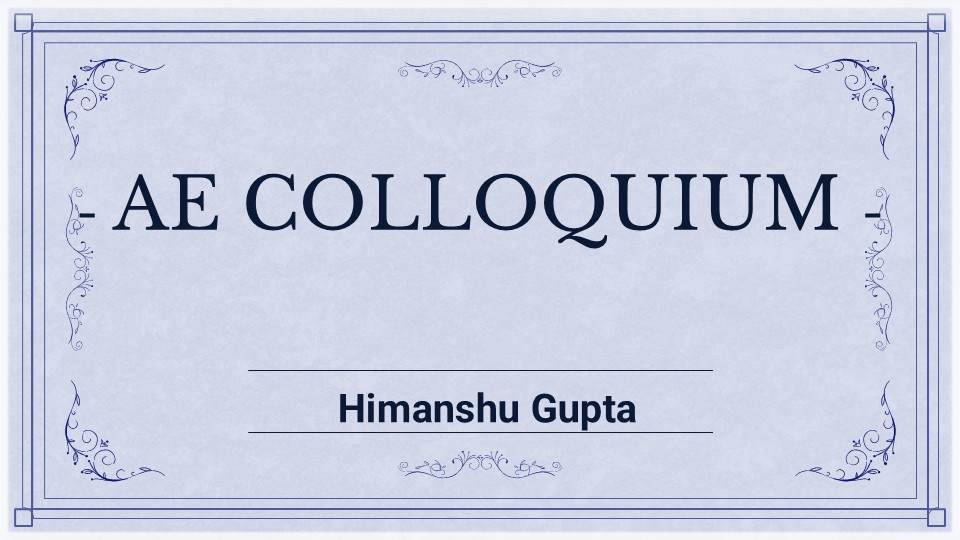
- This event has passed.
Ph.D.(Engg):Elastic Wave Propagation in Textured Polycrystalline Media
October 22 @ 3:30 PM - 5:00 PM

The performance and reliability of structural components in advanced engineering applications, such as turbine discs in aeroengines, are critically influenced by their microstructural characteristics, particularly the crystallographic texture. Texture controls the mechanical response of a material and ultimately governs the safe life of a component. Ultrasonic non-destructive evaluation (NDE) techniques offer a powerful way to routinely monitor such materials volumetrically; however, interpreting wave measurements in polycrystalline media is challenging due to structural noise, wave reflections and mode conversion. While numerical approaches enable the near-experimental exploration of elastic waves in such media, they are often computationally expensive.
This work addresses this challenge by developing a computationally efficient and experimentally supported simulation-driven framework to study elastic wave propagation in textured polycrystalline media and to recover intrinsic material properties, such as stiffness ( ) and density (
) and density ( ), from measured group velocities (
), from measured group velocities ( ). The work is structured in two major parts:
). The work is structured in two major parts:
First, forward simulations: Synthetic polycrystalline volume elements (PVE) were generated using DREAM.3D, subsequently embedded in COMSOL Multiphysics, where wave propagation studies were conducted on PVEs with controlled texture intensities (e.g., Cube {001} <100> and Copper {112} <111>), as well as with the experimentally informed microstructures. The results reveal that increasing texture intensity leads to more anisotropic group velocity and reduced wave scattering. To efficiently incorporate large experimental orientation datasets obtained from deformation and annealing textures, a reduced microstructural strategy was developed that preserves the texture information while significantly reducing computational cost. This approach provides experimental support for the small-sized PVEs, demonstrating their reliability in capturing the sense of the wave velocity governed by crystallographic texture.
Building upon the methodology developed, an application-based study was conducted on the dual-microstructure of the turbine disc to investigate the combined effects of grain size and grain orientation on wave velocity. The results showed the dominance of grain orientation over grain size, establishing texture as a crucial microstructural feature that governs elastic wave propagation and is also a prime indicator of the operational reliability of a component.
Second, inverse property identification: A frequency-domain inversion framework based on spectral finite element method (SFEM), and nonlinear least square optimization was formulated to estimate elastic stiffness ( ) and density (
) and density ( ) directly from the measured wave responses. This approach bypasses time-domain complexities and avoids dependence on prior material data, achieving accurate recovery of intrinsic properties even in the presence of scattering noise.
) directly from the measured wave responses. This approach bypasses time-domain complexities and avoids dependence on prior material data, achieving accurate recovery of intrinsic properties even in the presence of scattering noise.
The inversely predicted data ( ) were validated for both synthetic and experimentally informed microstructures using a wave-independent methodology (
) were validated for both synthetic and experimentally informed microstructures using a wave-independent methodology ( ) that displays an excellent agreement within
) that displays an excellent agreement within  4 % deviations. The results reveal how texture information can be inferred using uncertainty limits
4 % deviations. The results reveal how texture information can be inferred using uncertainty limits  and
and  , which are strongly influenced by microstructural scattering.
, which are strongly influenced by microstructural scattering.
Overall, the work establishes a computationally efficient and experimentally supported pathway for texture-sensitive applications, offering a rapid property identification in components where destructive methods are not feasible. These contributions enhance our understanding of wave-microstructure interactions and support the development of routine non-destructive evaluation of structural materials in aerospace and other critical engineering sectors.
Speaker : Himanshu Gupta
Research Supervisors : Prof. S. Gopalakrishnan & Prof. Satyam Suwas